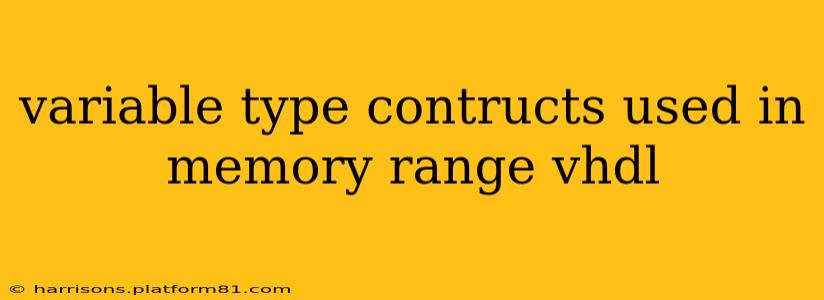VHDL (VHSIC Hardware Description Language) offers several ways to define and manage memory, crucial for designing digital systems. Understanding the variable type constructs used to specify memory ranges is vital for efficient and accurate hardware description. This guide delves into the key concepts, providing examples and explanations to clarify their usage.
Understanding Memory in VHDL
Before diving into specific constructs, let's clarify what constitutes memory in a VHDL context. Essentially, it refers to arrays of data elements, accessed using indices. These arrays can represent various memory structures, including RAM (Random Access Memory), ROM (Read-Only Memory), and registers. The crucial aspect is how we define the range of these arrays – the valid indices used to access the stored data.
Key Variable Type Constructs for Memory Range Specification
VHDL provides several ways to define the range of a memory array. The most common include:
1. Integer Range
This is the most straightforward approach, using integer literals to specify the starting and ending indices.
type my_memory_type is array (0 to 1023) of std_logic_vector(7 downto 0);
signal my_memory : my_memory_type;
In this example, my_memory is declared as an array of 1024 8-bit vectors (bytes), with indices ranging from 0 to 1023. The downto in std_logic_vector(7 downto 0) indicates the bit ordering, from most significant (MSB) to least significant (LSB).
2. Subtype Range
Subtypes allow you to create named ranges based on existing types, offering better code readability and maintainability.
subtype address_range is integer range 0 to 255;
type my_memory_type is array (address_range) of std_logic_vector(15 downto 0);
signal my_memory : my_memory_type;
Here, address_range defines a subtype representing addresses from 0 to 255. This improves code clarity by separating the address range definition from the memory type declaration.
3. Enumeration Range
If your indices aren't sequential integers, an enumeration type provides a more flexible solution. However, this is less common for memory addressing.
type state_type is (idle, read, write, error);
type state_memory_type is array (state_type) of integer;
signal state_memory : state_memory_type;
This example defines memory indexed by states, not numerical indices. Each state in state_type corresponds to a location in state_memory.
4. Using Constants for Enhanced Readability
Employing constants improves code clarity and simplifies modifications.
constant MEM_SIZE : integer := 1024;
constant DATA_WIDTH : integer := 8;
type my_memory_type is array (0 to MEM_SIZE -1) of std_logic_vector(DATA_WIDTH-1 downto 0);
signal my_memory : my_memory_type;
This example uses constants to define the memory size and data width, making the code more understandable and easily adjustable.
Handling Memory Initialization
You can initialize memory during declaration using aggregate values:
signal my_memory : my_memory_type := (others => (others => '0'));
This initializes all elements of my_memory to 8-bit zeros. others => '0' initializes all bits within each vector to '0'. This is particularly useful for ROM-like structures.
Choosing the Right Construct
The optimal construct depends on your specific needs. For simple, numerically indexed memories, integer ranges are sufficient. Subtypes offer better organization and readability for more complex designs. Enumerations are valuable when indices represent non-numerical concepts. Using constants enhances maintainability and readability, significantly benefiting large projects. Careful consideration of these options ensures efficient and well-structured VHDL code.
Frequently Asked Questions (FAQs)
How do I access elements within a memory array in VHDL?
Accessing elements is straightforward using the index:
my_memory(100) <= x"FF"; -- Assigns the hexadecimal value FF to the 101st element
y <= my_memory(50); -- Reads the 51st element into signal y
Can I use different data types within a single memory array?
No, a VHDL array must contain elements of the same type. If you need to store various data types, consider using records or structures as array elements.
What are the implications of using large memory arrays?
Very large arrays might impact synthesis and simulation times. Carefully consider the size and organization of your memory to optimize your design.
This comprehensive guide should equip you with the knowledge to effectively use various variable type constructs when defining memory ranges in your VHDL designs. Remember to always prioritize readability, maintainability, and efficiency in your code.
